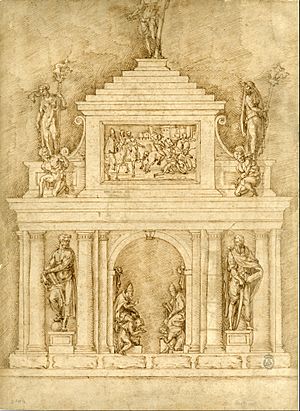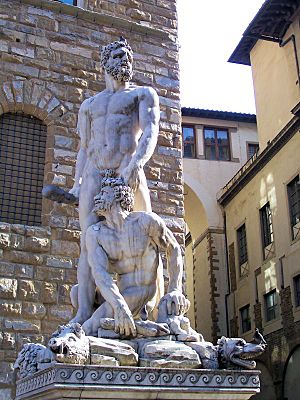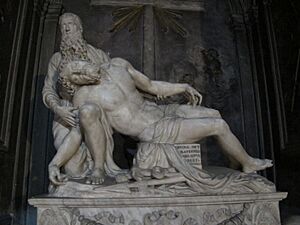Baccio Bandinelli facts for kids
Baccio Bandinelli (born Bartolommeo Brandini; 12 November 1493 – early 1560) was a famous Italian Renaissance sculptor. He was also a talented artist who made drawings and paintings.
Contents
Who Was Baccio Bandinelli?
Baccio Bandinelli grew up in Florence, Italy. His father was a well-known goldsmith. Baccio first learned his skills in his father's workshop.
As a young boy, he trained with Giovanni Francesco Rustici. Rustici was a sculptor and a friend of the famous artist Leonardo da Vinci. One of Baccio's first works was a wax sculpture of Saint Jerome. He made it for Giuliano de' Medici, a powerful leader.
Bandinelli and Michelangelo
Bandinelli was always very interested in the work of Michelangelo. He spent his whole career trying to be as good as, or even better than, Michelangelo.
Bandinelli was a key artist in Florence. He was part of a group called the Mannerists. These artists were inspired by the older sculptor Donatello. Donatello's detailed artworks were very popular at the time.
Bandinelli made a sculpture called the Deposition. He showed it to Emperor Charles V in 1529. This artwork showed strong feelings, much like Donatello's pieces.
The Hercules and Cacus Statue
Bandinelli's sculptures are not as famous as Michelangelo's. A good example is his huge marble statue of Hercules and Cacus. This statue is over 5 meters tall! It was finished in 1534. You can see it in the Piazza della Signoria in Florence. It stands near some of Michelangelo's greatest works.
Many people thought Bandinelli's finished marble statues were not as good as his smaller models. One art historian said he was a "brilliant draughtsman and excellent small-scale sculptor." But he struggled with very large sculptures. He wanted to copy Michelangelo, but it was hard for him on a grand scale.
Creating Hercules and Cacus
The Hercules and Cacus statue was ordered by Pope Clement VII. He was a member of the powerful Medici family. The Pope liked Bandinelli's wax model for the statue.
The marble block for the statue was not big enough. So, Bandinelli had to make new models. The Pope chose one of these new designs. Bandinelli started carving the statue.
In 1527, there was a big attack on Rome. The Pope was captured. In Florence, people who were against the Medici family took over. Bandinelli, who supported the Medici, had to leave Florence.
In 1530, Emperor Charles V took Florence back. Pope Clement VII then put his son Alessandro de' Medici in charge of Tuscany. Bandinelli returned to Florence and finished the statue in 1534.
Public Reaction to the Statue
When the Hercules and Cacus statue was first shown, many people made fun of it. Another famous artist, Benvenuto Cellini, said it looked like "a sack full of melons." After this, Bandinelli tried to cause problems for Cellini's career.
The statue was cleaned and fixed in 1994.
Bandinelli's Students
Bandinelli's drawings are now highly valued. For a long time, some of them were even thought to be by Michelangelo!
Some of Bandinelli's students became famous artists themselves. These included Giorgio Vasari and Francesco de' Rossi (Il Salviati). His sons, Clemente and Michelangelo Bandinelli, also became sculptors. Clemente worked with his father in his studio.
Famous Works by Baccio Bandinelli
Here are some of Baccio Bandinelli's important artworks:
- Copy of the Laocoön group: This was a famous ancient Roman statue. Pope Leo X asked Bandinelli to make a copy as a gift for the King of France. Bandinelli said he would make it even better than the original! The Pope liked Bandinelli's copy so much that he kept it in Florence. It is now in the Uffizi Gallery.
- Tombs of the Medici Popes: He created tombs for Pope Leo X and Pope Clement VII. These are in the Santa Maria sopra Minerva church in Rome (1536–41).
- Bust of Cosimo I de' Medici (around 1539–40): This is a sculpture of the head and shoulders of Cosimo I de' Medici, a powerful ruler of Florence. It is now in the Metropolitan Museum of Art.
- Monument to Giovanni delle Bande Nere (1540–54): This is a statue of a seated figure on a grand base. It is in the Piazza San Lorenzo in Florence.
- Pietà in the Basilica della Santissima Annunziata, Florence: In this sculpture, Bandinelli included himself. He is shown as Joseph of Arimathea. Bandinelli and his wife are buried in this chapel.
- Ceres and Apollo (1552–1556): These statues were made for a special grotto (a cave-like structure) in the Boboli Gardens in Florence.
- Orpheus: This statue is now in the courtyard of the Palazzo Medici-Riccardi in Florence. It is one of the few works Bandinelli signed.
- Works for the Duomo: He made several pieces for the main cathedral in Florence. These include the high altar and its Adam and Eve (1551), which is now in the Bargello Museum. He also made detailed carvings for the choir area.
- Works in Palazzo Vecchio: In the Audience Hall, he made a statue of Grand Duke Cosimo I de' Medici. He also started a statue of Pope Leo X blessing, which was finished by another artist after Bandinelli's death.
- God the Father (1549): This sculpture is in the Santa Croce cloister.
- Andrea Doria as Neptune: This statue is outside the Carrara Cathedral. It was first made to honor Andrea Doria, a leader from Genoa. But when Florence took control of Carrara, the statue was renamed Neptune, the Roman god of the sea. This made it less of a symbol of Genoa.
- Other works in the Bargello Museum: This museum has many of Bandinelli's smaller works. These include Noah (a relief sculpture), busts (head and shoulders sculptures) of Eleonora di Toledo and Cosimo I de' Medici, and statues of Venus, Leda, Hercules, Bacchus, and Cleopatra.
See also
 In Spanish: Baccio Bandinelli para niños
In Spanish: Baccio Bandinelli para niños
- Portrait of a Lady known as Smeralda Bandinelli by Botticelli (portrait of Baccio's grandmother)





